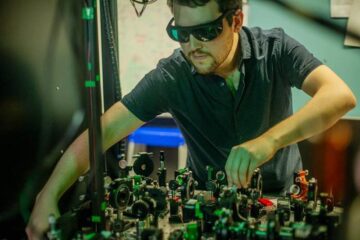How Copper Folds Protein into Parkinson's Plaques

The protein in question, alpha-synuclein, is the major component of fibrillar plaques found in Parkinson’s patients. Researchers had already discovered that certain metals, including copper, could increase the rate of misfolding by binding with the protein, but were unsure of the mechanism by which this binding took place.
“We knew that the copper was interacting with a certain section of the protein, but we didn’t have a model for what was happening on the atomic level,” says Frisco Rose, Ph.D. candidate in physics and lead author of the paper describing the research. “Think of a huge swing set, with kids all swinging and holding hands – that’s the protein. Copper is a kid who wants a swing. There are a number of ways that copper could grab a swing, or bind to the protein, and each of those ways would affect all of the other kids on the swing set differently. We wanted to find the specific binding process that leads to misfolding.”
Rose and NC State colleagues Dr. Miroslav Hodak, research assistant professor of physics, and Dr. Jerzy Bernholc, Drexel Professor of Physics and Director of the Center for High Performance Simulation, developed a series of computer simulations designed to ferret out the most likely binding scenario.
According to Hodak, “We simulated the interactions of hundreds of thousands of atoms, which required multiple hundred thousand CPU-hour runs to study the onset of misfolding and the dynamics of the partially misfolded structures.”
The number of calculations was so large that Hodak and Bernholc had to devise a new method to make it possible for a computer to process them. Only supercomputers like Jaguar, Oak Ridge National Laboratory’s most powerful supercomputer – the most powerful in the United States, in fact – were up to the task. But the simulations finally revealed the binding configuration most likely to result in misfolding.
Their results appear in the June 14 edition of Nature Scientific Reports.
The researchers hope that their finding will advance our understanding of Parkinson’s, one of the most common – and devastating – neurological diseases. “Understanding the molecular mechanism of Parkinson's disease should help researchers in developing drugs that treat the disease rather than merely alleviate symptoms,” Bernholc says.
The research was funded by the Department of Energy and the National Science Foundation. The Department of Physics is part of NC State’s College of Physical and Mathematical Sciences.
Note to editors: An abstract of the paper follows.
“Mechanism of copper(II)-induced misfolding of Parkinson’s disease protein”
Authors: Frisco Rose, Miroslav Hodak, Jerzy Bernholc, North Carolina State University
Published: June 14, 2011 in Nature Scientific Reports
Abstract:
á-synuclein (áS) is a natively unfolded pre-synaptic protein found in all Parkinson’s disease patients as the major component of fibrillar plaques. Metal ions, and especially Cu(II), have been demonstrated to accelerate aggregation of áS into fibrillar plaques, the precursors to Lewy bodies. In this work, copper binding to áS is investigated by a combination of quantum and molecular mechanics simulations. Starting from the experimentally observed attachment site, several optimized structures of Cu-binding geometries are examined. The most energetically favorable attachment results in significant allosteric changes, making áS more susceptible to misfolding. Indeed, an inverse kinematics investigation of the configuration space uncovers a dynamically stable â-sheet conformation of Cu-áS that serves as a nucleation point for a second â-strand. Based on these findings, we propose an atomistic mechanism of copper-induced misfolding of áS as an initial event in the formation of Lewy bodies and thus in PD pathogenesis.
Media Contact
More Information:
http://www.ncsu.eduAll latest news from the category: Life Sciences and Chemistry
Articles and reports from the Life Sciences and chemistry area deal with applied and basic research into modern biology, chemistry and human medicine.
Valuable information can be found on a range of life sciences fields including bacteriology, biochemistry, bionics, bioinformatics, biophysics, biotechnology, genetics, geobotany, human biology, marine biology, microbiology, molecular biology, cellular biology, zoology, bioinorganic chemistry, microchemistry and environmental chemistry.
Newest articles

Combatting disruptive ‘noise’ in quantum communication
In a significant milestone for quantum communication technology, an experiment has demonstrated how networks can be leveraged to combat disruptive ‘noise’ in quantum communications. The international effort led by researchers…

Stretchable quantum dot display
Intrinsically stretchable quantum dot-based light-emitting diodes achieved record-breaking performance. A team of South Korean scientists led by Professor KIM Dae-Hyeong of the Center for Nanoparticle Research within the Institute for…

Internet can achieve quantum speed with light saved as sound
Researchers at the University of Copenhagen’s Niels Bohr Institute have developed a new way to create quantum memory: A small drum can store data sent with light in its sonic…





















